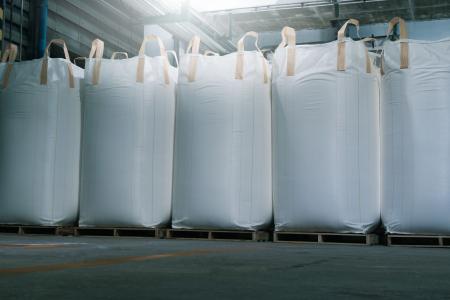Big Bags are often used in the industry to store and transport bulk goods.
Various aspects regarding the Big Bag are discussed in this article:
- The deployment of the Big Bag
- Construction of the Big Bag
the experts of dinnissen process technology are available to answer all of your questions:
Get in touch with Juul Jenneskens 077 467 3555
The deployment of the Big Bag
A Big Bag is a large bag that is widely used in the industry for storing and transporting bulk goods. It is estimated that 380 million are deployed each year. Bulk goods are materials that cannot be individually packed and loaded. This mainly concerns dry bulk goods, such as building materials, sand, gravel, nutrients, agricultural products, grain, chemicals, mineral raw materials, wood chips and debris.
Officially the name Flexible Intermediate Bulk Container (FIBC) applies, but in practice the term “Big Bag” is almost always used. Sometimes the term “bulk bag” is also used.
The use of Big Bags has many advantages over other ways of storage and transport. Big Bags are:
- very cost efficient,
- easy in use,
- fully meet the strict requirements of the food and pharmaceutical industry with regard to hygiene,
- very strong, have a very high load-bearing capacity and can hold more than 1000 times its own weight,
- simple and effective as a product carrier and do not require secondary packaging,
- small in size when unfilled and then require little storage space,
- fully customizable for specific applications,
- suitable as a promotional medium by printing on it.

Big Bag
Construction of the Big Bag
There are various sizes of Big Bags. The standard Big Bag has a capacity of 1 - 1.3 m3. A well-filled Big Bag is 1.5 m high and fits on a Euro pallet. Standard dimensions are: 65x65x75 cm, 80x80x80 cm and 90x90x110 cm. At the top there are four loops at the corners with which the bag can be lifted, can be held open during filling and can be tied closed during transport.
Big Bags are often made of woven polypropylene or polyethylene and are intended to be reused. In order to be able to reuse the Big Bags often and for a long time, they are usually made of polypropylene that is provided with a UV stabilizer. Sometimes Big Bags are covered on the inside with an extra layer that is intended to prevent fine powder from escaping through the pores of the fabric of the Big Bag.
Viewed from above or below, the Big Bag has a square shape. However, when the Big Bag is filled, it will take on a more cylindrical shape. That is a disadvantage, especially when there is only limited storage space available. In that case, more space will be needed to put the Big Bags next to each other and to stack them, more than would be the case if the Big Bag were to retain its square cross-section during filling.
To prevent the Big Bags from losing their square / rectangular shape during filling, they are sometimes provided with reinforcements in the corners so that the 3 ribs at the corners remain at an angle of 90o to each other. With a Big Bag reinforced in this way, it is possible to stack in a neater way. In addition, space savings of up to approximately 20% are possible.
With the help of high-frequency vibrations it is possible to achieve an even more optimal sieving result. especially for the sieving of small particles, this technique provides a high efficiency

Name: Juul Jenneskens
Advisor
Please feel free to contact me if you have any questions about this subject. My team of colleagues and I are ready to answer!
Get in touch with Juul Jenneskens 077 467 3555 [email protected]
Do you prefer to request a consultation directly?
